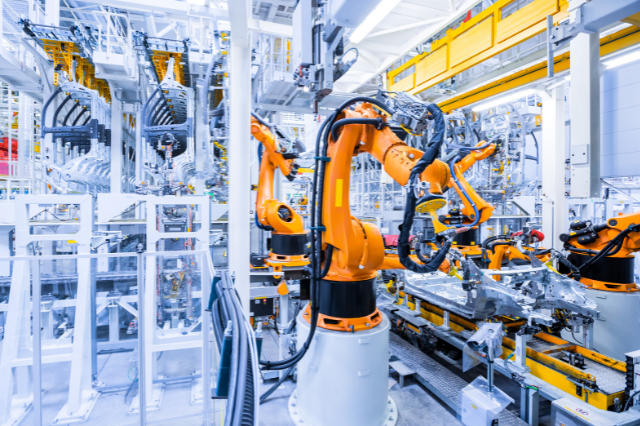
Imagine a world where human error in manufacturing is a distant memory; a world where production continues 24/7, unaffected by vacations, sick days, or sleep. Welcome to the next wave of manufacturing, ushered in by robotics and automation. This is not the future; it's happening as we speak. But just how, you might ask, are robotics and automation revolutionizing the manufacturing industry? Let's delve in and explore.
For starters, it's important for us to remember that robotics and automation aren't just about replacing human labor. That’s a common misconception. The truth is, these innovative technologies extend far beyond simply doing the work of humans; they are pioneering new methods and standards in manufacturing that humans alone could not achieve.
In this article, we’ll take a closer look at these aspects, examining how the manufacturing landscape is being reshaped, and what this means for the industry's future.
The Rise of Robotics and Automation in Manufacturing
Imagine this; you're walking through a vast manufacturing floor, but instead of rows of workers laboriously assembling products, you're met with an army of robots, tirelessly performing tasks with unprecedented speed and precision. Welcome to the era of robotics and automation in manufacturing; a revolution we are currently witnessing.
But what does this rise of robotics and automation mean? It means we are entering a new age where human labor is progressively being replaced by machines. Machines that work efficiently without tiring, machines that can perform repetitive tasks accurately without making a single mistake. In many manufacturing sectors, these robotic counterparts are certainly bringing about drastic operational changes while also promising considerable benefits.
A new vision of manufacturing is emerging; a vision that embraces the possibilities of the future while acknowledging the realities of the past and present. It's not just an industrial revolution; it's akin to a renaissance, redefining the contours of industries. Robotics and automation aren't just changing manufacturing; they're reinventing it.
Take the automotive sector, for instance: where once humans painted vehicles, auto painting robots now perform this task. What's the result? Consistency, productivity, and a significant decrease in waste. Similarly, in the electronic gadget manufacturing sector, small robots assemble intricate circuits, something which is painstaking for humans.
Indeed, we're witnessing a shift from human-operated processes to automated systems and machines; a transformation made possible by the rapid advancements in robotics and technology.
However, like many revolutions, the rise of robotics and automation in manufacturing brings both enthusiasm and concern. Enthusiasm for innovation, efficiency, and potential economic growth; concern about job displacement and societal change. Yet, it's an unavoidable evolution; one that compels us to ponder on how we can best harness the potential of these technologies to benefit humanity at large.
In conclusion, the rise of robotics and automation is not just a trend but a paradigm shift in the manufacturing industry. It's a bold reminder that in the face of rapid technological change, we must adapt, innovate, and rethink traditional methods. Revolutionary? Certainly. Inevitable? Absolutely. Inspiring? Without a doubt!
How Automation is Transforming Manufacturing
Have you ever considered the magnitude of changes we are experiencing, changes that are redefining the manufacturing industry landscape as we know it? Imagine this; human hands that were once the backbone of production lines in factories are gradually being replaced by automated machines. Yes, we are talking about the awe-inspiring power of robotics and automation. In the twinkling of an eye, these technologies are enhancing productivity, reducing errors, and entirely reshaping manufacturing processes.
Let's delve deeper into this transformative trend, shall we?
The everyday manufacturing process is witnessing an unprecedented change; assembly lines are becoming more technology-intensive. High-precision tasks that once required the analytical minds and skilled hands of human workers are now carried out by smart machines with an unmatched level of accuracy. You wonder, how does this happen? Well, it's all thanks to sophisticated programming and elaborate mechanical systems that closely mimic, and often exceed, human aptitudes.
Now, what might this mean for the future of manufacturing? Hold that thought; we'll touch on it in detail later. Right now, allow your mind to picture the production floor crowded with automated machines performing tasks to perfection. These are not ordinary machines, mind you; we're talking about unerring cybernetic systems cleverly designed to eliminate human error.
All this automation, of course, doesn't happen in a vacuum. The increasing use of the Internet of Things (IoT) technology is also playing a significant role in this transformation. IoT devices serve as the eyes and ears of automation systems, capturing data in real time and communicating it back to the robotic systems. This allows the machines to adjust and optimize their actions based on this feedback. Isn't that impressive?
In short, the remarkable fusion of robotics, automation, and IoT has given manufacturing a quantum leap into the future. The influence of this cannot be underestimated; it extends far beyond the factory floor, reshaping supply chains, business models, and even the global economic fabric.
So, isn't it fascinating how automation is imprinting its digital footprints across the manufacturing industry? And the journey, it seems is just beginning; the true potential of such technologies is yet to be fully unearthed.
Next up, we'll explore the advantages of incorporating robotics into manufacturing. Is there more to all this than meets the eye? Stay tuned!
Advantages of Incorporating Robotics in Manufacturing
rightfully so. Robots are faster, more accurate, and can work without any breaks, unlike their human counterparts. They can perform repetitive tasks with a level of precision that's hard for humans to replicate. However, the advantages of incorporating robotics in manufacturing extend far beyond efficiency.
Robots enhance the productivity of the manufacturing process. With their ability to work 24/7, they dramatically increase the output levels. And it doesn't stop there; by taking care of mundane and repetitive tasks, they free up human workers to take on more meaningful roles — roles that require creativity, critical thinking, or a human touch. This not only improves overall productivity but also leads to a more engaged and fulfilling work environment for employees.
But what about safety, you might ask? Isn't it risky having robots around humans in the same workspace? Well, contrary to popular belief, using robots can actually reduce workplace accidents. If programmed correctly, most modern-day robots are designed to stop immediately when they make contact with an object or person in their path. Moreover, they can be deployed to carry out strenuous and hazardous tasks that have historically posed health and safety risks to humans.
| Advantage | Explanation |
|---|---|
| Efficiency | Robots can work faster and make fewer mistakes than humans. |
| Productivity | With the ability to work 24/7, robots can increase output levels. |
| Employee Engagement | By taking over repetitive tasks, robots allow humans to focus on more value-adding roles. |
| Safety | Robots can perform tasks that are potentially dangerous to humans, reducing workplace accidents. |
By now, it should be abundantly clear that the advantages of incorporating robotics in manufacturing are compelling. They not only increase efficiency and productivity, but also improve employee engagement and ensure a safer working environment. But they don't take jobs away. Instead, they transform jobs, creating new roles centered around managing and maintaining these robotic systems.
As we move forward, the integration of robotics in manufacturing is not just an option, it's becoming a necessity. Prepare yourself to welcome our future colleagues — the robots.


